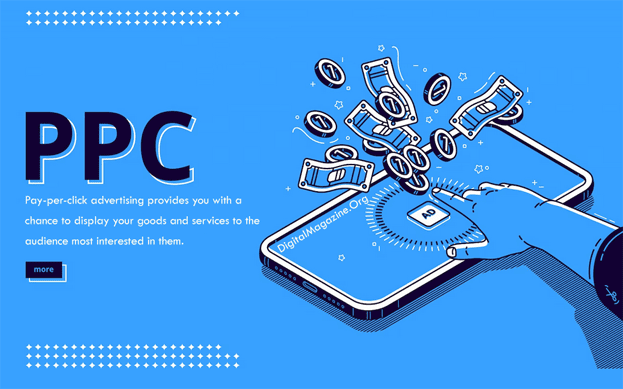
Guide To Pay-Per-Click Advertising: Have you ever thought about why some businesses seem to appear unexpectedly when you’re searching for their products or services? You enter a search query into a search engine such as Google, and voilà! A relevant advertisement appears. You just experienced the effectiveness of Pay-Per-Click (PPC) advertising.
In this manner, advertisers are charged a fee whenever a web user clicks on one of their advertisements. Rather than getting traffic organically, such as through Search Engine Optimization (SEO), businesses can purchase site visits through PPC.
If you want to appear on the first page of search engine results, Pay-Per-Click advertising could be the way to go. This guide will describe how the process works and how to monitor your complete advertising campaign.
How Does PPC Work?
You select keywords related to your product or service using PPC and then create an advertisement. When someone searches for that keyword, your advertisement may be displayed.
The PPC procedure is founded on a bidding and auction system. When a user searches for a product or service, an auction for active advertising space gets started. Advertisers bid on keywords and specify how much they are prepared to pay when users click on their ad.
The success of an offer depends not only on the highest bidder but also on the ad’s relevance and quality. You may require the help of a marketing agency or an experienced freelance PPC consultant during the tendering phase. These professionals can help you choose suitable keywords, and bid amounts, and create effective advertisements.
Pay-Per-Click advertising is available in various formats, each offering distinct benefits and serving unique marketing objectives. It is up to you to choose the best marketing strategy for your goals.
Which Types of PPC Advertising Are Available?
These are the most common Pay-Per-Click advertising types:
1. Search Advertising
Your advertisements appear in search engine results when a user searches for a product or service. Imagine that you own a local bakery. Someone in your city is looking for the “best pastries nearby.” With the proper keywords and bidding strategy, your ad could be the first one they encounter. Search advertising is most effective for businesses seeking rapid visibility and customer conversion, particularly in industries with high demand.
2. Display Advertising
Display advertising extends your advertisements beyond the results of search engines. In most cases, they will appear on websites your potential customers visit. These advertisements may be banners, frames, or interactive videos, among different types. Due to its expansive display network, display advertising is ideal for brand awareness and reach.
3. Social Media Advertising
Facebook, Instagram, and LinkedIn are social media platforms that offer PPC advertising options. These platforms grant you access to their extensive user bases, where you will likely discover a demographic interested in your products and services.
4. Remarketing
Remarketing or retargeting targets individuals who have previously interacted with your company but have not yet made a purchase. For instance, a website visitor adds a box of macarons to their shopping cart but does not conclude the transaction.
In the future, when browsing a blog or monitoring their social media feed, they may come across an advertisement for your bakery. It is an example of classic remarketing. It is an easy reminder to your visitor that they left something behind.
How do you build a campaign now that you know the various Pay-Per-Click advertising types? It is how.
Creating Your First PPC Campaign
To get started with a PPC campaign, you must take the following steps:
1. Clarify Your Objectives
What do you wish to achieve? More website visitors? Enhanced sales? Define this initially.
2. Select the Correct Platform
Your decision will depend on your audience and objectives. Google is the go-to search engine for most users. If you’re targeting professionals, however, a PPC campaign on LinkedIn may be more effective.
3. Keyword Analysis
Use tools like Google Keyword Planner to set the correct keywords. If you sell gardening tools, you could use the keywords ‘quality gardening tools’ or ‘affordable gardening shears’ as keywords.
4. Ad Copy
Create a concise advertisement that motivates people to engage. For instance, “Transform your garden with our affordable, high-quality tools!”
Keeping these best practices for pay-per-click advertising in mind, the next stage involves monitoring and assessing how well your PPC campaign is doing. It is how you can go about doing it:
Tracking and Evaluating the Performance of PPC Ads
It would be best if you concentrated on analytics to assess how well Pay-Per-Click advertising is working for you. Tools such as Google Analytics may show you the number of individuals who clicked on your advertisement, the most successful keywords, and the percentage of clicks that resulted in purchases.
When using analytics, it is recommended that one focus on the following strategies as best practices:
1. Click-Through Rate (CTR)
The percentage of individuals who see your advertisement and then go on to click on it.
2. Cost Per Click (CPC)
The amount of money you pay for the benefit of having a user click on your ad is the same as the amount of money you pay for the service.
3. Conversion Rate
The percentage of users who carry out an intended activity, such as making a purchase, after clicking on your advertisement.
After determining which elements of your Pay-Per-Click advertising are successful and which are not, you must make adjustments to get the best possible results. To determine which version of your pay-per-click (PPC) text performs the best, you must regularly analyze your keywords and use the A/B testing method.
Also Read;
Final Thoughts
Pay-per-click advertising could seem too complicated to understand at first glance. Nevertheless, you are well on your way to being an expert if you consult helpful manuals like this and work with an encouraging marketing professional.
When done correctly, PPC provides you with a fantastic chance to display your goods and services to the audience most interested in them. Take advantage of it now and see how much of a difference it can make for your company.



